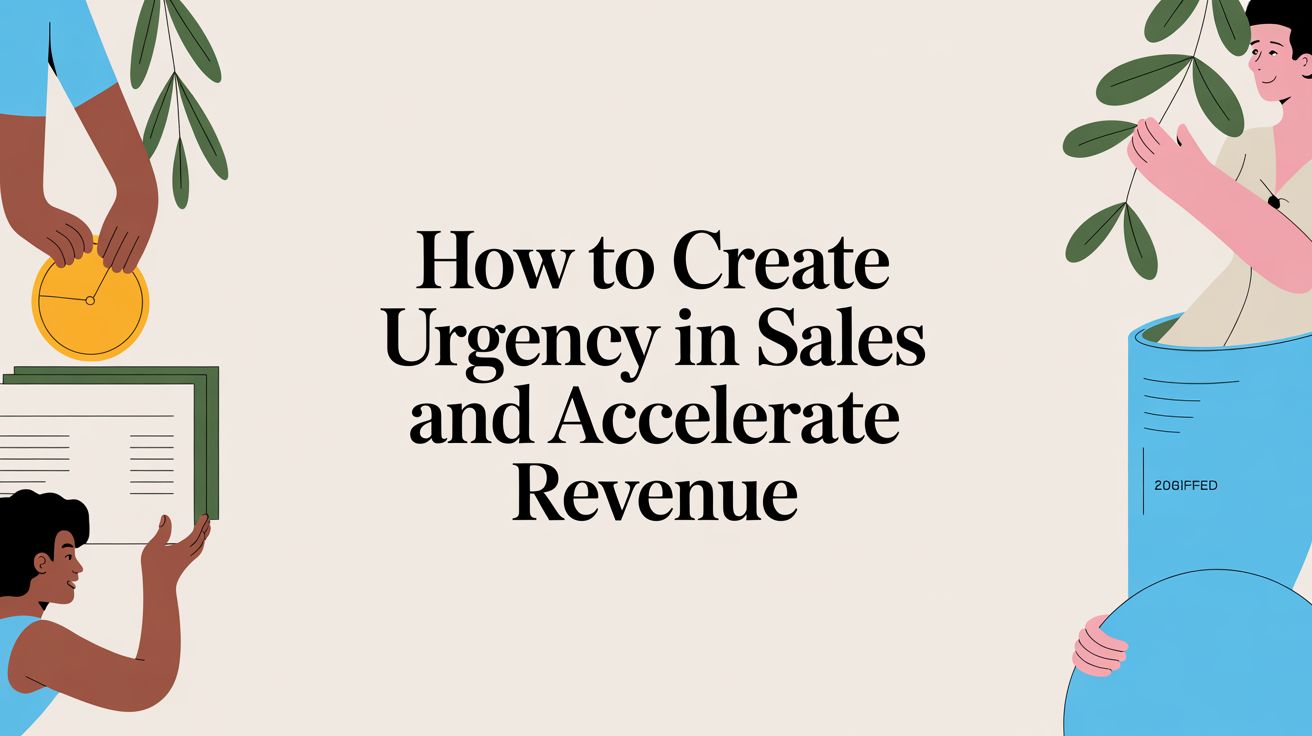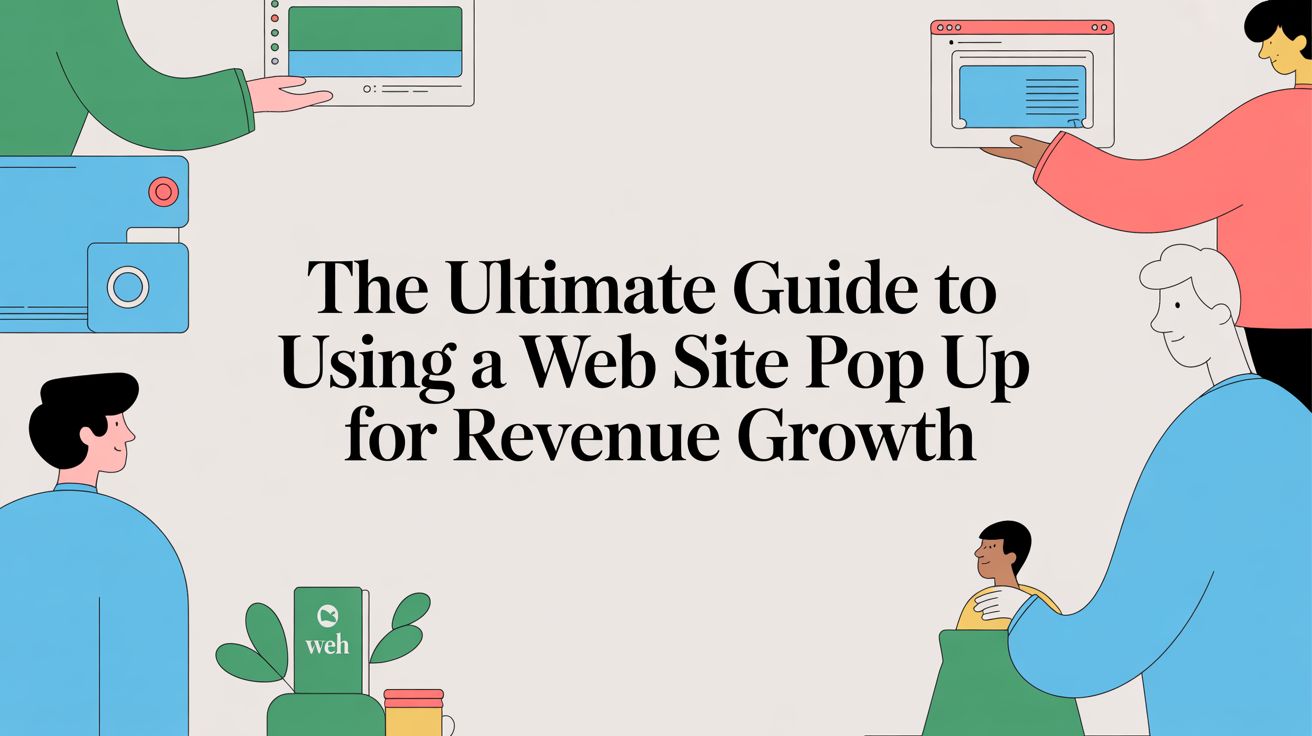
Increase Ecommerce Conversions with Urgency Marketing
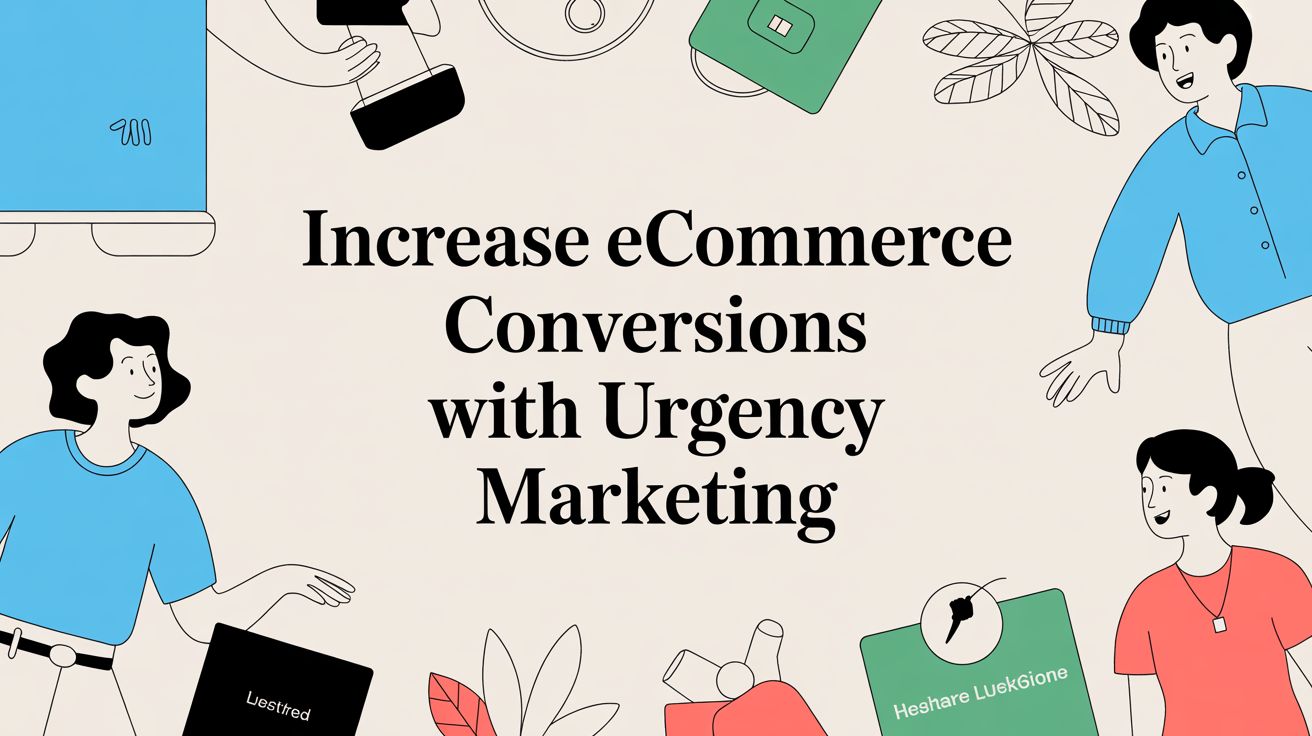
To truly increase ecommerce conversions, you must first face the financial reality of a low conversion rate. It's not just a lost sale; it's a domino effect that erodes ad spend efficiency, inflates operational costs, and ultimately, shrinks your profit margins. Understanding this ROI impact is the first step toward building a more profitable business.
The True Business Impact of Low Conversions
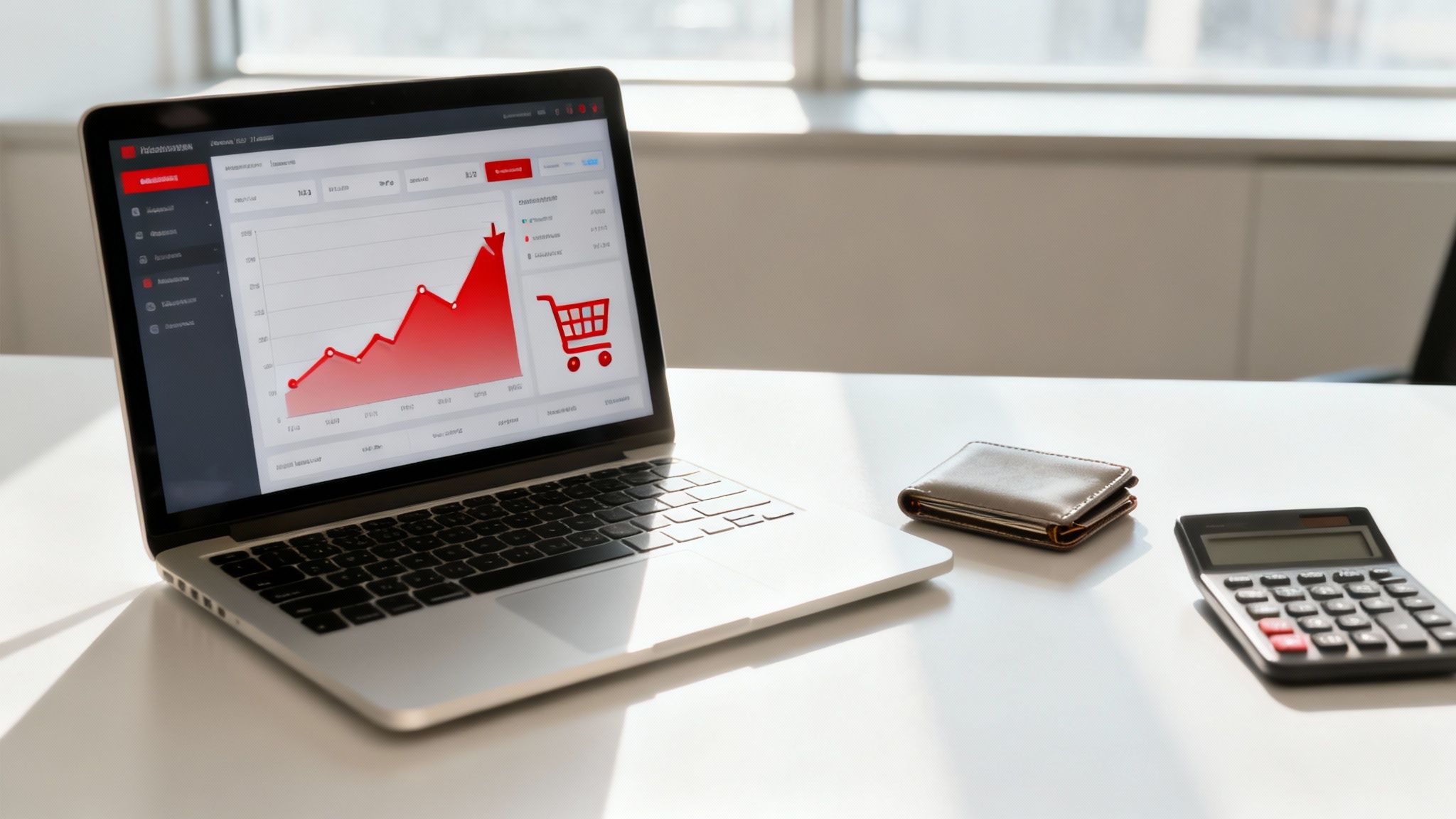
A low conversion rate isn’t just another metric on your dashboard; it’s a direct threat to your profitability. While the global average ecommerce conversion rate sits around 2.5%, accepting that benchmark means 97 out of every 100 visitors you paid to acquire leave empty-handed. This inefficiency has a direct and significant impact on your return on investment (ROI).
Consider the financial leakage: every dollar pumped into Google Ads or social media campaigns becomes less effective. If you spend $1,000 to bring 1,000 visitors to your Shopify store and only 25 convert (a 2.5% rate), your customer acquisition cost (CAC) is a painful $40. By doubling that conversion rate to 5%, your CAC is immediately halved to $20, dramatically boosting your return on ad spend (ROAS) and adding pure profit to your bottom line.
Beyond the Initial Sale
The damage doesn't stop at ad spend. A stagnant conversion rate points to deeper issues in your customer journey. It signals friction and hesitation, often caused by a behavioral economics principle known as analysis paralysis—where too many choices or insufficient motivation cause shoppers to freeze and abandon their carts.
This is a primary driver behind the staggering industry-wide cart abandonment rate of nearly 70%. Each abandoned cart represents more than lost revenue; it's wasted inventory allocation, squandered marketing automation resources, and a missed opportunity to build a customer relationship.
Actionable Takeaway: Frame conversion optimization through an ROI lens. The primary goal is not just to increase sales but to maximize the revenue generated from every visitor you've already paid to attract.
This financial pressure is intensifying. With global ecommerce sales projected to surpass $6.8 trillion in 2025, competition is fierce and customer expectations are at an all-time high.
To get a better grip on how to track your progress, check out our guide on how to measure marketing campaign effectiveness. You can also find some great platform-specific strategies for boosting your Amazon conversion rate that can broaden your optimization toolkit.
The Psychology Behind Effective Urgency Marketing
To meaningfully increase ecommerce conversions, you must move beyond basic countdown timers. True urgency marketing is not about creating pressure; it's the sophisticated application of behavioral science designed to help shoppers make confident, timely decisions. The most successful brands understand that urgency isn't a tactic—it's about tapping into deep-seated psychological motivators to guide the customer journey.
At its core, this strategy leverages fundamental human drivers. Principles like scarcity (limited quantity) and the Fear of Missing Out (FOMO) activate what behavioral economists call loss aversion. This cognitive bias, proven by extensive research, shows that the pain of losing something feels approximately twice as powerful as the pleasure of gaining it. When a customer sees "Only 3 left in stock," their brain isn't just processing information; it's experiencing a visceral reaction to the potential loss of an opportunity.
Beyond Basic Timers and Popups
Many common popup apps are one-dimensional, focusing on a single action like email capture. While list building is valuable, this approach often interrupts the shopping journey and misses the primary objective: driving immediate revenue.
Similarly, a generic countdown timer that runs perpetually on a product page quickly becomes background noise. This trains customers to ignore it, rendering the tactic useless. This is where Quikly's science-backed approach creates a clear differentiation. Instead of generic, site-wide timers, the strategy shifts to creating dynamic urgency "Moments"—sophisticated behavioral triggers that align with specific points in the customer's journey. It’s about understanding why a customer hesitates and applying the precise psychological nudge at the right time. For a deeper analysis, explore the principles of consumer psychology and why urgency causes action.
An Ethical Application of Behavioral Economics
Viewed through the lens of consumer psychology, urgency ceases to be about manipulation and becomes a tool for guidance. You are ethically helping customers overcome decision paralysis by providing a clear, compelling reason to act now. This does more than just boost conversions; it also protects profit margins by reducing reliance on constant, margin-killing discounts and helps with inventory management by moving products more predictably.
By orchestrating urgency based on real inventory levels, genuine time constraints, and social proof, you build trust. This ethical approach turns a casual browser into a decisive buyer, improving both immediate revenue and long-term brand loyalty.
Consider the contrast: a generic "Sale Ends in 24 Hours" banner versus a targeted notification showing "5 other shoppers are viewing this item right now." The first is marketing noise. The second is a powerful, real-time application of social proof that validates the shopper's interest and gently compels them to purchase before someone else does.
This is what separates basic tools from advanced revenue-generation platforms. The table below breaks down these two approaches.
Basic Timers vs Sophisticated Urgency Marketing
| Feature | Basic Countdown Timers / Popups | Sophisticated Urgency (e.g., Quikly Moments) |
|---|---|---|
| Primary Goal | Single action (e.g., email capture) | Drive revenue across the full customer journey |
| Psychology | Surface-level FOMO (often generic) | Deep application of behavioral science (loss aversion, social proof) |
| Implementation | Static, site-wide banners or popups | Dynamic, personalized "Moments" tied to specific user actions |
| Customer Experience | Often disruptive and can feel fake | Feels helpful, informative, and authentic |
| Impact on Brand | Can lead to "banner blindness" and erode trust | Builds trust and brand loyalty through transparency |
| Business Outcome | Incremental list growth | Significant, measurable increases in conversion and revenue |
Ultimately, a sophisticated strategy grounds your marketing in authentic, real-time data. It guides customers instead of pressuring them, creating a better experience that leads to more sales and stronger loyalty.
Applying Urgency Tactics Across the Customer Journey
Understanding the psychology is one thing; applying it to generate a measurable impact on revenue is another. It’s not about randomly placing a timer on a product page. The real ROI comes from strategically mapping psychological triggers to key moments of hesitation along the entire customer journey. For merchants on Shopify Plus, this becomes even more potent when integrated with your tech stack, enabling scarcity alerts to be delivered seamlessly via Klaviyo emails or Attentive SMS messages.
This process involves layering psychological principles: use anticipation to build excitement, scarcity to create value, and social proof to validate the purchase decision.
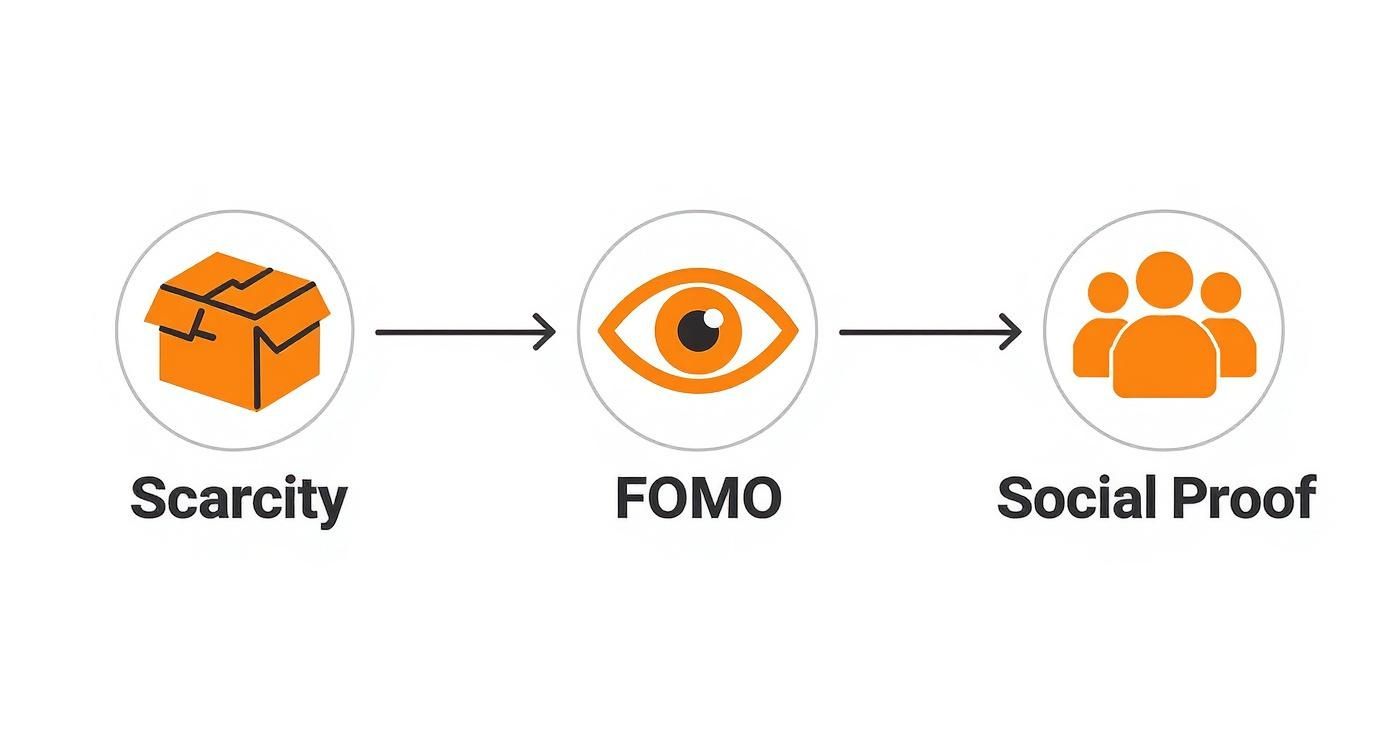
As the visual shows, these concepts build on each other, guiding a shopper from just browsing to confidently clicking "buy." You're essentially turning passive interest into action.
The Homepage Build-Up
Your homepage is your digital storefront window, the perfect place to build anticipation. Instead of a generic "Shop Now" banner, use this prime real estate to tease an upcoming limited-edition drop or hint at a flash sale. This reframes a simple shopping trip into an event.
You’re creating a "Moment" that taps into a powerful psychological driver, priming your audience and building excitement before the sale even begins. By the time it goes live, you have a motivated audience ready to convert.
Actionable Takeaway: Use your homepage banner to announce a limited-time offer starting soon. For Shopify stores, this can be easily updated via the theme customizer to build anticipation for upcoming campaigns.
The Product Page Nudge
The product detail page (PDP) is the decision-making battleground. This is your moment to layer in scarcity and social proof to overcome hesitation. A static timer is easily ignored, but dynamic, data-driven messages feel authentic and compelling.
Here’s what that looks like in practice:
- Inventory Scarcity: A message like, "Only 5 left at this price!" triggers loss aversion, making the fear of missing out tangible.
- Real-Time Social Proof: Subtle notifications like, "12 people have this in their cart," create a sense of competition and validate the shopper's choice. It communicates that the item is desirable.
The data supports this. Adding user-generated content (UGC) like customer photos and reviews can boost conversions by up to 8.5%. To dig deeper, check out these conversion rate optimization statistics that show just how much trust signals influence buying behavior.
The Cart Abandonment Guard
With cart abandonment rates stubbornly hovering around 70%, the checkout is a major revenue leakage point. Here, urgency serves as a helpful reminder to reinforce the purchase decision.
Actionable Takeaway: Implement a cart timer or a message like, "Complete your order in the next 10 minutes to guarantee stock." This leverages scarcity to combat last-minute indecision without resorting to discounts that erode profit margins.
This is a smart tactic that protects your margins by converting a sale that was about to be lost. The cart becomes less of a holding area and more of a decisive final step.
Optimizing Urgency for Mobile Shoppers
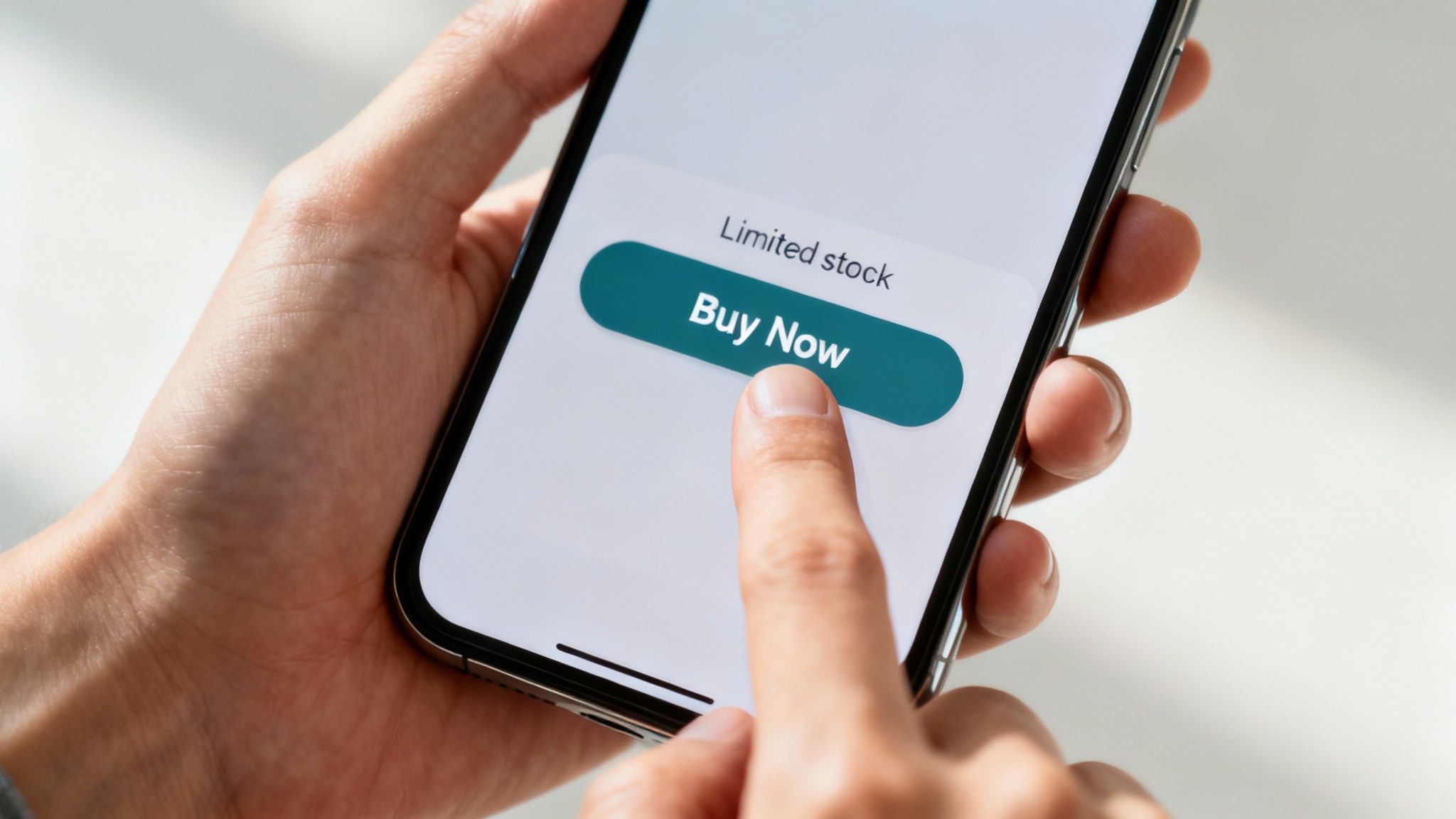
Ignoring the mobile experience is one of the fastest ways to leak revenue. Today, a mobile-first approach is essential, as the journey must be optimized for a user who is often distracted and always short on time.
The data is clear. While e-commerce conversion rates average around 2.5%, mobile devices now drive a staggering 73% of all ecommerce traffic. This massive audience will not tolerate a clunky experience.
Your urgency marketing must therefore be more intelligent and less intrusive on a small screen. A large, screen-blocking popup that might convert on a desktop is a session-killer on a phone, leading directly to frustration and a bounce.
Designing for Thumbs and Taps
Effective mobile urgency is about subtle integration. It should enhance the flow, not disrupt it. Think sleek banners and notifications that guide the shopper.
Here are a few practical ways to tailor your strategy for mobile:
- Sticky Banners: A thin, persistent banner at the top or bottom of the screen is ideal for a countdown timer or a low-stock alert. It keeps urgency visible without obstructing the user experience.
- Thumb-Friendly CTAs: Ensure your "Buy Now" or "Add to Cart" buttons are large, easy to tap, and positioned where a thumb naturally rests.
- Streamlined Forms: Reduce your checkout process to the absolute minimum. For Shopify Plus merchants, enabling express payment options like Shop Pay, Apple Pay, and Google Pay is non-negotiable for reducing friction.
Actionable Takeaway: On mobile product pages, replace disruptive popups with a non-intrusive sticky banner at the top of the screen displaying real-time stock levels (e.g., "Only 4 left"). This maintains urgency without hindering navigation.
Integrating Urgency Into the Mobile Journey
Sophisticated platforms like Quikly let you create "Moments" specifically designed for mobile users. You can even integrate these triggers with SMS tools like Attentive or email marketing platforms like Klaviyo to build a cohesive campaign that reaches shoppers wherever they are.
Beyond just creating urgency, it's worth exploring different mobile app monetization strategies to find more ways to engage and convert your mobile audience. For a deeper dive, our guide on how to make your mobile app more engaging with urgency marketing offers tactics you can put into action right away: https://hq.quikly.com/blog/how-to-make-your-mobile-app-more-engaging-with-urgency-marketing.
Ultimately, the key is to see mobile optimization not as a technical chore, but as an exercise in consumer psychology for people on the go.
Measuring the ROI of Your Urgency Strategy
Deploying an urgency strategy without clear measurement is like flying blind. To truly know if your efforts to increase ecommerce conversions are successful, you must look beyond the conversion rate and analyze the tangible financial impact on your business. A robust strategy doesn't just drive sales—it builds sustainable revenue while protecting profit margins. The goal is to prove a clear return on investment (ROI).
This means shifting focus from vanity metrics to the key performance indicators (KPIs) that directly affect your bottom line.
Moving Beyond the Conversion Rate
An increase in your conversion rate is a positive signal, but it doesn't tell the whole story. A truly effective urgency campaign should generate positive effects across several core financial metrics. When you use sophisticated automation, like Quikly's "Moments," you're aiming to impact the entire business.
Here’s what you should really be tracking:
- Average Order Value (AOV): Are shoppers adding more to their carts? Smart urgency tactics, like a "Free shipping on orders over $75" banner combined with a timer, can encourage customers to add another item, directly boosting AOV.
- Customer Lifetime Value (LTV): When you use psychology-driven tactics ethically, you build trust. Trust leads to repeat purchases, transforming one-time buyers into loyal customers with a significantly higher LTV.
- Profit Margin Protection: By using behavioral triggers like authentic scarcity and social proof, you can create compelling reasons to buy now without resorting to steep, sitewide discounts that erode your margins.
By focusing on these core business metrics, you can draw a straight line from your urgency strategy to revenue and profitability. That makes a much stronger case for its value than a simple conversion rate bump ever could.
Proving Impact with A/B Testing
The most definitive way to measure ROI is through rigorous A/B testing. This data-driven approach removes guesswork and reveals which psychological triggers resonate most effectively with your audience. For high-traffic merchants on Shopify Plus, this is essential for optimizing campaigns and maximizing returns.
A classic test involves comparing a sophisticated urgency trigger against a basic one, or against no urgency at all.
Imagine this scenario:
- Variant A (Control): Your standard product page.
- Variant B (Basic Urgency): The same page with a generic "Sale ends in 24 hours" countdown timer.
- Variant C (Sophisticated Urgency): The page features a dynamic message like, "Only 4 left in stock! 15 other people are looking at this item right now."
After the test, analyze not just the conversion rate but also the AOV and total revenue generated by each variant. Did the sophisticated trigger, rooted in scarcity and social proof, not only convert more visitors but also encourage them to spend more? This provides clear, actionable data to refine your strategy for maximum financial impact.
Answering Your Questions About Urgency Marketing
As you explore urgency marketing, questions will naturally arise. Addressing these is key to implementing an effective, ethical strategy that enhances your brand rather than detracts from it.
Let’s tackle some of the most common questions.
Is Urgency Marketing Manipulative?
This is a critical concern. The answer depends entirely on authenticity. When urgency is fabricated—like a countdown timer that resets upon refresh—it is deceptive and manipulative. Customers are savvy and will see through such tactics, leading to a permanent loss of trust.
However, when urgency is grounded in truth, it becomes helpful information. Informing a shopper that only three units of a desired product remain is not a trick; it is transparent communication that helps them avoid the disappointment of a "Sold Out" notice. The goal of ethical urgency is to guide with real data, not deceive with fake pressure.
What Is the Difference Between Scarcity and Urgency?
These terms are often used interchangeably, but they are distinct psychological triggers that motivate action in different ways.
- Urgency Marketing is a broad strategy that uses time- or quantity-based limitations to encourage immediate action. It often leverages psychological principles like scarcity and FOMO.
- Scarcity is a specific principle within urgency marketing focused on quantity. Messages like "Only 5 left in stock" or "Limited edition" tap into our fear of missing out on a limited supply.
- Urgency (as a tactic) is focused on time. Phrases like "Sale ends tonight" or "Order in the next 30 minutes for free shipping" create a deadline that compels an immediate decision.
The most powerful campaigns often combine them. A flash sale on a limited-stock item is a classic example that leverages both time and quantity for maximum impact.
Can Urgency Marketing Hurt My Brand?
Yes, if it is overused or feels inauthentic. Constant "last chance" sales and perpetual countdown timers lead to "urgency fatigue," training customers to ignore your messaging. This devalues your products and can make your brand appear desperate.
The objective is not to create a constant state of high pressure. It is to create strategic, authentic "Moments" of urgency tied to genuine opportunities that feel special.
Moderation and authenticity are paramount. Sophisticated automation helps by triggering urgency based on real-time shopper behavior and actual inventory levels. This ensures the experience always feels relevant, credible, and aligned with your brand's integrity.
Ready to move past basic timers and start creating sophisticated, revenue-driving Moments? Discover how Quikly uses the science of urgency to help Shopify's top brands increase conversions while protecting their profit margins. See how it works.

The Quikly Content Team brings together urgency marketing experts, consumer psychologists, and data analysts who've helped power promotional campaigns since 2012. Drawing from our platform's 70M+ consumer interactions and thousands of successful campaigns, we share evidence-based insights that help brands create promotions that convert.
